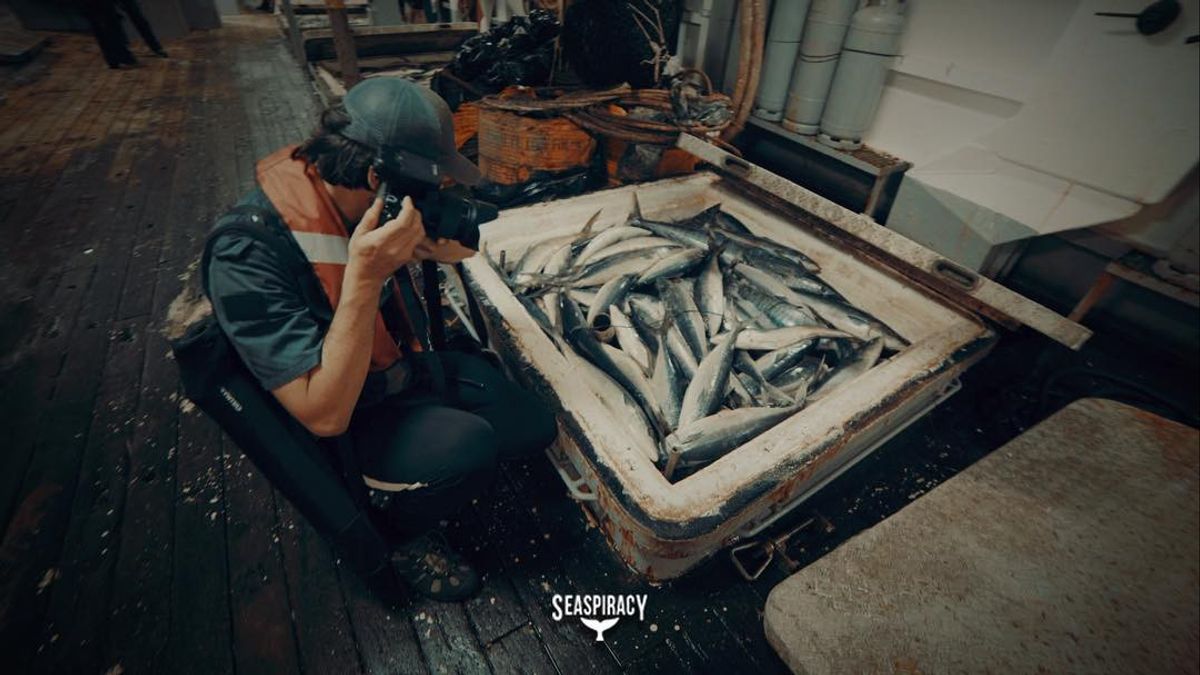JAKARTA - If you think our plastic waste is the biggest threat to marine life, you are right. But wait until you arrive at a dozen minutes of the documentary Seaspiracy. The initial perspective will change. Not our straws or cutlery. The greatest threat to the ocean is 'the fish on our table'. A very interesting discourse, even though the conclusion is arguably controversial.
Distributed film streaming service, Netflix, Seaspiracy, directed by Ali Tabrizi. Seaspiracy tests our point of view on ocean issues. As explained above, instead of exploring how the plastics we use are a threat to the survival of the sea, Seaspiracy presents a more serious fact about the real threat of the sea caused by the fishing industry.
Ali Tabrizi and his film team take the audience to explore the world's coasts and oceans. From Japan, Liberia, to Thailand. Taiji, Japan is the first phase, when we see whales and dolphins being slaughtered. Not for consumption, but for pest control. In the eyes of the fishing industry players, dolphins and whales are 'rivals' because of their consumption patterns which eat a lot of small fish.
"It is surprising how whales and dolphins are slaughtered. There is no large enough market to place the two animals for consumption," Ali Tabrizi throws a narrative of astonishment in the film before he gets the answer above.
[MEMORY: Historical Decision: Japan to Stop Whaling]

From Taiji, Seaspiracy takes the audience to other deepings, including overfishing of tuna. Apart from sacrificing many other marine biota, tuna fishing also opens up a new discourse about the labeling of marine food that is dolphin friendly and sustainable. Ali and his team visited the international agency authorized to provide the labels, the Marine Stewardship Council (MSC).
In a short interview, an MSC representative is depicted going round and round answering the question of how do they ensure that packaged fish fishing does not involve violence or the slaughter of other marine animals?
"You send monitors to the ocean? How often are they at sea" asked Ali.
"Yes (there are observers). But they are not too intense at sea," replied the representative.
"How do you guarantee the" Dolphin Safe "label when your monitor isn't out of the ocean?" Ali.

"No one guarantees that. Moreover, they (monitors) could have been bribed," said the MSC representative.
"You said you could guarantee. Now you have doubts. How can labeling really guarantee the truth of the facts on the ground?" Ali pressed again.
"Of course we can guarantee the labeling even though we can't guarantee fishing in the field, like, you know life is sometimes hard," said the representative.
Shocking facts about the oceansThat's Seaspiracy. He is able to present surprising facts to the audience. Apart from the issue of whale and dolphin hunting as a pest eradication and questionable seafood labels, Seaspiracy also provides a lot of other information.
1. The oceans are drained
Fishing activities have wiped out 90 percent of the big fish in the oceans, including various species of sharks, whales and tuna. Apart from that, fishing also destroys turtles.
Every year in the United States (US), 250 thousand turtles are caught, injured, or even died as a result of fishing activities. Compared with a global survey, that figure is far more than 100 thousand turtles that die from plastic pollution in the oceans.
2. Domination nets of marine debris
As explained earlier. Plastic is a threat to the ocean that we have recognized so far. Not completely wrong.
However, the data Seaspiracy describes shows a real threat: fishing nets. Opening up the data, Seaspiracy shows that fishing nets are a type of garbage that dominates the oceans.
Unmitigated. The percentage reaches 46 percent. In a simple analogy, Seaspiracy explains that fishing net waste that is thrown away every day is capable of binding the earth's diameter up to five hundred times.

[/ read_more]
3. Slavery of the seafood industry
Seaspiracy also raises the issue of slavery in the seafood industry, aka seafood. And in fact, it's precarious.
According to the published data, slavery in the seafood industry is widespread in 47 countries. Recorded slavery includes those that involve violence to murder.
4. Big money into the ocean
Money flows from the oceans to the land. Money also flows from land to sea. Seaspiracy underlines how the authorities of world countries poured at least 35 billion US dollars into the oceans.
The money was used to support what Ali Tabrizi and his film team called "sea looting." So it is ironic because according to data from the United Nations (UN), it only takes 30 billion US dollars to deal with the problem of hunger in the world.
5. The future of the earth is in the oceans
So far, we know the Amazon rainforest as the largest carbon sink in the world. We were wrong. The sea that helps Earth breathe.
Is a creature called phytoplankton which is described as the most powerful carbon sink. Their numbers that were previously abundant in the oceans are now running low.
How can? Seaspiracy takes us along the chain of continuity between all of this: fishing, phytoplankton, to the sustainability of the earth.
Phytoplankton have been fed from whales. Now the number of whales is dwindling, which makes the survival of phytoplankton threatened.
Who dies after phytoplankton dies? We.
[/ read_more]
Controversial conclusion

Watching Seaspiracy is a journey that ends in confusion. Of course. So far, we believe that eating fish is very important.
In Indonesia, where we live, in particular. The fish eating movement has been intensified widely through government programs and campaigns.
For the people of Indonesia, eating fish is not only an effort to fulfill nutrition, but also a movement to rotate the economic wheels of the coastal community. The conclusion of Seaspiracy was also highlighted by Christina Hicks.
Christina Hicks is a professor who is also in the film Seaspiracy. Some time ago he tweeted in response to the conclusion of the film that Ali Tabrizi and his team had sewn together.
The fishing industry, said Christina Hicks, has experienced a lot of progress. What happened was not as terrible as what Ali Tabrizi described in Seaspiracy.
And most importantly, Christina Hicks warns that eating fish is still important for food security and nutrition in many vulnerable areas.
Unnerving to discover your cameo in a film slamming an industry you love & have committed your career to. I've a lot to say about # seaspiracy- but won't. Yes there are issues but also progress & fish remain critical to food & nutrition security in many vulnerable geographies. pic.twitter.com/gKlopL64Gt
- Christina Hicks (@ChristinacHicks) March 26, 2021
* Read other information about FILM or read other interesting writings from Yudhistira Mahabharata.
BERNAS Others[/ read_more]
The English, Chinese, Japanese, Arabic, and French versions are automatically generated by the AI. So there may still be inaccuracies in translating, please always see Indonesian as our main language. (system supported by DigitalSiber.id)









